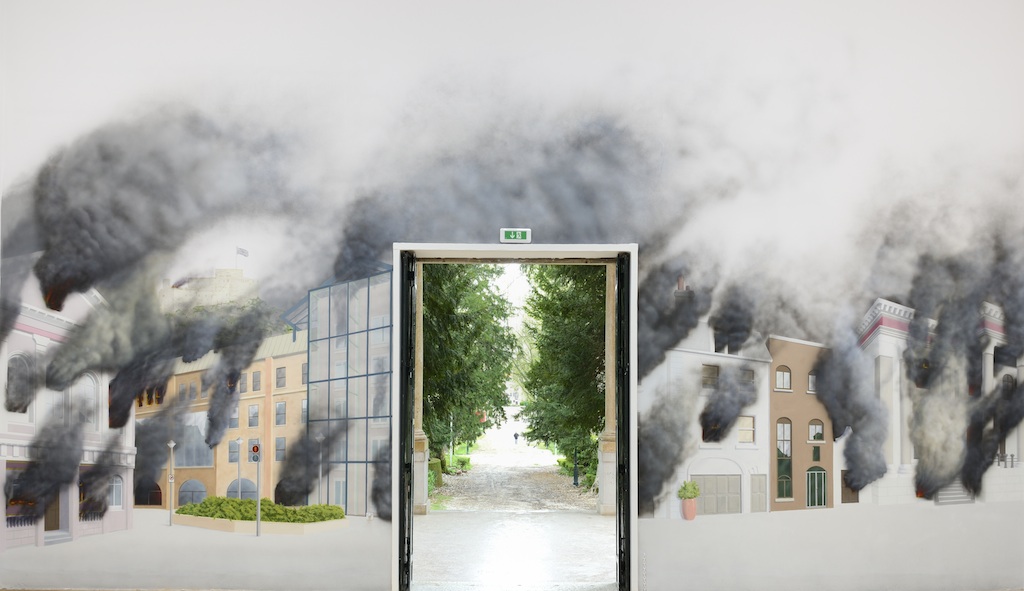Jeremy Deller: English Magic, William Morris Gallery | reviews, news & interviews
Jeremy Deller: English Magic, William Morris Gallery
Jeremy Deller: English Magic, William Morris Gallery
The artist's British Pavilion display at last year's Venice Biennale comes to London

As you may recall, Jeremy Deller represented Britain at last year’s Venice Biennale and a distilled version of English Magic, his British Pavilion show, is now installed in the William Morris Gallery in Walthamstow. It's an especially relevant first stop on a tour that continues to Bristol and Margate, since Morris features large in Deller’s idiosyncratic commentary on British culture.
William Morris is best known as the brains behind the Arts and Crafts movement and designer of those famous wallpaper patterns, but he was also an ardent socialist keen to improve the lot of the poor – not by overturning capitalism, but by giving workers a more equal share. Housed in the Georgian mansion where Morris spent his affluent childhood, the museum is a treasure trove of goodies including furniture, carpets, textiles and stained glass by the Victorian entrepreneur and his associates.
The abstraction of the banners speaks more to art historians than to the man in the streetDeller’s exhibition starts on the ground floor and infiltrates the cafe, stairs and landing. Filling one wall is a mural featuring Morris as a vengeful colossus rising from the turquoise waters of the lagoon to pluck Roman Abramovich’s yacht from its moorings and cast it into the depths (main picture). In 2011, the monstrous vessel not only laid claim to the territory, but prevented visitors from strolling along the promenade to the Gardini, where the Biennale is held. Deller’s message is clear: money cannot be allowed to dominate the proceedings.
A display of the coupons and vouchers issued by the post-Soviet regime during the privatisation of state-run enterprises reminds us that many Russian oligarchs amassed their fortunes through nefarious dealings. However, they're not the only targets of the artist’s wrath.
 Money rather than yachts are parked in the island tax haven of Jersey and another mural (pictured above) shows the capital, St Helier, going up in smoke. The conflagration is predicted for 2017, but the banners egging on the rioters have already been designed by Ed Hall, a specialist in campaign banners. The mask-like faces are based on a tax avoidance diagram and a deliberately opaque financial scheme known as the “Jersey Cashbox".
Money rather than yachts are parked in the island tax haven of Jersey and another mural (pictured above) shows the capital, St Helier, going up in smoke. The conflagration is predicted for 2017, but the banners egging on the rioters have already been designed by Ed Hall, a specialist in campaign banners. The mask-like faces are based on a tax avoidance diagram and a deliberately opaque financial scheme known as the “Jersey Cashbox".
 Hung on the stairwell, the banners lead you upstairs to a group of drawings (pictured right: Basra in my sights by Andy, HMP Everthorpe) made by soldiers who served in Iraq or Afghanistan, but are now doing time in Her Majesty's prisons. Portraits of Tony Blair, Dr David Kelly and Alastair Campbell – protagonists in the debate over the pros and cons of going to war against Saddam Hussein – are juxtaposed with scenes of army life which paint a dismal picture. Slumped on a bed against a union flag are two squaddies smoking crack at Wellington Barracks the night before deployment, while under another bed a soldier lies rigid with fear during an enemy attack in Basra.
Hung on the stairwell, the banners lead you upstairs to a group of drawings (pictured right: Basra in my sights by Andy, HMP Everthorpe) made by soldiers who served in Iraq or Afghanistan, but are now doing time in Her Majesty's prisons. Portraits of Tony Blair, Dr David Kelly and Alastair Campbell – protagonists in the debate over the pros and cons of going to war against Saddam Hussein – are juxtaposed with scenes of army life which paint a dismal picture. Slumped on a bed against a union flag are two squaddies smoking crack at Wellington Barracks the night before deployment, while under another bed a soldier lies rigid with fear during an enemy attack in Basra.
Meanwhile, on video, a Range Rover is crushed to a pulp and various birds of prey go through their glorious paces in slow-mo, while a steel band plays David Bowie's The Man Who Sold the World. It helps to remember that, in 2007, Prince Harry and a friend were suspected of shooting two protected hen harriers out of the sky over Sandringham, but no-one was charged.
The Jersey mural is an incitement to riot. Each section of the show – from the ill-gotten gains and excessive influence of the tax-avoiding super-rich, to our ill-considered military exploits and our royals apparently flouting the law by killing endangered species – is, in fact, a potential bombshell. So why does the exhibition feel so terribly tasteful and polite?
 It's partly the lack of an authorial voice – Deller (pictured left) employs others to paint the murals, design the banners and do the drawings – and partly a matter of style. The delicacy and precision of the murals dilutes the rage they depict into a mild “tut” of disapproval; the abstraction of the banners speaks more to art historians than to the man in the street; the anger of the squaddies is lost in the awkward timidity of their pencil drawings, while untangling the relationship between the various video sequences – including birds of prey, Chelsea tractors and footage of the Lord Mayor’s show – requires insider information that isn’t available to all.
It's partly the lack of an authorial voice – Deller (pictured left) employs others to paint the murals, design the banners and do the drawings – and partly a matter of style. The delicacy and precision of the murals dilutes the rage they depict into a mild “tut” of disapproval; the abstraction of the banners speaks more to art historians than to the man in the street; the anger of the squaddies is lost in the awkward timidity of their pencil drawings, while untangling the relationship between the various video sequences – including birds of prey, Chelsea tractors and footage of the Lord Mayor’s show – requires insider information that isn’t available to all.
Deller is no rabble rouser; he likes to keep things subtle, oblique and somewhat fragmented. His target audience is made up of well-informed sophisticates who enjoy unravelling coded information and recognise that, despite its angry subject matter, the work offers no actual threat. That's why the establishment loves him.
Overleaf: watch footage of Jeremy Deller and the making of English Magic
Explore topics
Share this article
Add comment
The future of Arts Journalism
You can stop theartsdesk.com closing!
We urgently need financing to survive. Our fundraising drive has thus far raised £49,000 but we need to reach £100,000 or we will be forced to close. Please contribute here: https://gofund.me/c3f6033d
And if you can forward this information to anyone who might assist, we’d be grateful.

Subscribe to theartsdesk.com
Thank you for continuing to read our work on theartsdesk.com. For unlimited access to every article in its entirety, including our archive of more than 15,000 pieces, we're asking for £5 per month or £40 per year. We feel it's a very good deal, and hope you do too.
To take a subscription now simply click here.
And if you're looking for that extra gift for a friend or family member, why not treat them to a theartsdesk.com gift subscription?
more Visual arts
 'We are bowled over!' Thank you for your messages of love and support
Much-appreciated words of commendation from readers and the cultural community
'We are bowled over!' Thank you for your messages of love and support
Much-appreciated words of commendation from readers and the cultural community
 Folkestone Triennial 2025 - landscape, seascape, art lovers' escape
Locally rooted festival brings home many but not all global concerns
Folkestone Triennial 2025 - landscape, seascape, art lovers' escape
Locally rooted festival brings home many but not all global concerns
 Sir Brian Clarke (1953-2025) - a personal tribute
Remembering an artist with a gift for the transcendent
Sir Brian Clarke (1953-2025) - a personal tribute
Remembering an artist with a gift for the transcendent
 Emily Kam Kngwarray, Tate Modern review - glimpses of another world
Pictures that are an affirmation of belonging
Emily Kam Kngwarray, Tate Modern review - glimpses of another world
Pictures that are an affirmation of belonging
 Kiefer / Van Gogh, Royal Academy review - a pairing of opposites
Small scale intensity meets large scale melodrama
Kiefer / Van Gogh, Royal Academy review - a pairing of opposites
Small scale intensity meets large scale melodrama
 Jenny Saville: The Anatomy of Painting, National Portrait Gallery review - a protégé losing her way
A brilliant painter in search of a worthwhile subject
Jenny Saville: The Anatomy of Painting, National Portrait Gallery review - a protégé losing her way
A brilliant painter in search of a worthwhile subject
 Abstract Erotic, Courtauld Gallery review - sculpture that is sensuous, funny and subversive
Testing the boundaries of good taste, and winning
Abstract Erotic, Courtauld Gallery review - sculpture that is sensuous, funny and subversive
Testing the boundaries of good taste, and winning
 Edward Burra, Tate Britain review - watercolour made mainstream
Social satire with a nasty bite
Edward Burra, Tate Britain review - watercolour made mainstream
Social satire with a nasty bite
 Ithell Colquhoun, Tate Britain review - revelations of a weird and wonderful world
Emanations from the unconscious
Ithell Colquhoun, Tate Britain review - revelations of a weird and wonderful world
Emanations from the unconscious
 Rachel Jones: Gated Canyons, Dulwich Picture Gallery review - teeth with a real bite
Mouths have never looked so good
Rachel Jones: Gated Canyons, Dulwich Picture Gallery review - teeth with a real bite
Mouths have never looked so good
 Yoshitomo Nara, Hayward Gallery review - sickeningly cute kids
How to make millions out of kitsch
Yoshitomo Nara, Hayward Gallery review - sickeningly cute kids
How to make millions out of kitsch
 Hamad Butt: Apprehensions, Whitechapel Gallery review - cool, calm and potentially lethal
The YBA who didn’t have time to become a household name
Hamad Butt: Apprehensions, Whitechapel Gallery review - cool, calm and potentially lethal
The YBA who didn’t have time to become a household name

Comments
I haven't seen the whole show
I haven't seen the whole show yet, but I thought the film was both magical and witty. The steel band - the wonderful Melodians of south London - begins with an amazing transcription of the Romanza from Vaughan Williams' Fifth Symphony to illustrate the slow motion birds of prey: in itself a paradigm of what England was and is now.
Sarah Kent's dissatisfaction
I have no idea what
I have no idea what "contradiction" you're pointing to. Do you? I have no idea what "paid-to-view" has to do with it and I don't know how you deduce that our model is "implicitly geared to those with a professional interest in the arts". This latter assertion seems to be a projection of your own belief about criticism and who it might and might not appeal to. That aside, and this is a very simple point, you can criticise a piece of work that you think fails by its own rules, while not subscribing to those rules, whatever they may be, yourself. Does that make sense? Furthermore, in a piece of criticism, it's not the critic's job to advise the artist on how he or she might do things differently, or to envisage "new forms" or "offer alternatives". We raise questions, and probe, and we say why we think something may not work, and why it does. That is the critic's job. I hope that's clear.